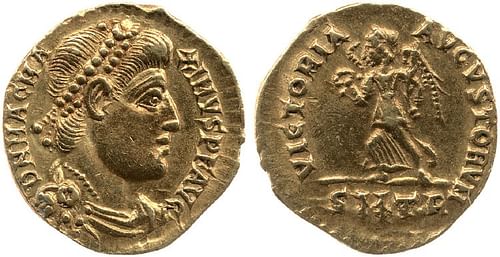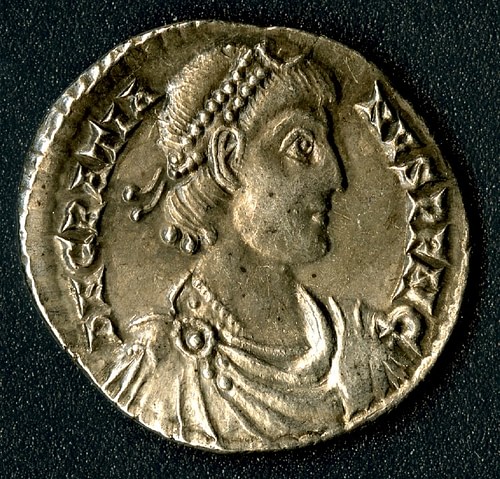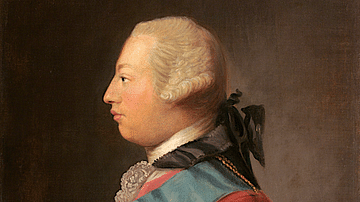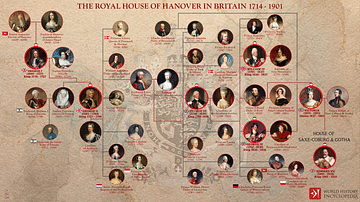
Magnus Maximus (c. 355 - August 28, 388 CE) was a Roman usurper and Western Roman Emperor from 383-388 CE. He was a prominent general in the Roman army, particularly in the province of Britain. In 383 CE he usurped the Western throne, rebelling against the legitimate emperor Gratian. Following Gratian's death, negotiations with the Eastern Emperor Theodosius led to Maximus being proclaimed ruler of Britannia and Gaul, while Gratian's brother Valentinian II retained Italy, Spain, Pannonia, and Africa. Maximus eventually invaded Italy, bringing him into direct conflict with Theodosius. He was defeated by Theodosius' forces at the Battle of the Save in 388 CE. He was able to flee but was later captured and executed in the city of Aquileia in August of 388 CE.
Early Life & Military Career
Magnus Maximus was born into a noble family in the Roman province of Gallaecia, modern-day Galicia in northwest Spain. He was a nephew of Count Theodosius the Elder, the father of the emperor Theodosius I. As part of a military family, Maximus was raised to be a soldier and commander. He grew to be a skilled tactitian and commander, achieving the rank of general. He served in a number of campaigns under the elder Theodosius throughout the empire. Maximus is believed to have held a junior command post somewhere in Britain in 368 CE.
It was in 368 CE that Maximus aided Count Theodosius to put down the Great Conspiracy (367-368 CE). The Conspiracy occurred when the Roman Garrison at Hadrian's Wall in northern Britain rebelled and allowed a confederation of tribes to enter imperial territory. The invaders included Picts and Scots as well as Saxons and Franks from the Continent. Maximus probably played an important role in helping Count Theodosius fight off the invaders and regain lost territory.
Maximus further distinguished himself as a general under Theodosius in Africa c. 373 CE and on the Danube c. 376 CE. He was eventually stationed in Britain again in 380 CE where he was the supreme military commander of the Roman forces and seems to have put down a rebellion or invasion of Scots and Picts in 381 CE.
Usurpation & Reign in the West
Maximus was extremely popular with his troops at a time when the Western Emperor, Gratian (r. 367-383 CE), was becoming more and more unpopular. Emperor Valens (r. 364-378 CE) had been killed at the disastrous Battle of Adrianople (378 CE) fighting a coalition of Gothic, Hunnic, and Alan tribes. Following this, Gratian apparently took to using a band of Alan bodyguards and dressing in a similar fashion, alienating his Roman troops. Maximus perhaps observed this and waited a proper time to take advantage. At some point in 383 CE, Maximus was proclaimed emperor by his own troops. Soon after this, he crossed over into Gaul with his forces including a significant portion of the British military garrison to seize power.

Maximus established his court in the city of Augusta Treverorum, modern-day Treves/Trier, in Gaul. From there, he ruled Britain, Gaul, Hispania, and parts of Africa. He became popular as a ruler and was known for a number of civil and military reforms. As a military commander, he became known for using troops from surrounding regions, known as foedorati, to great effect, including the Alemanni and other Germanic-speaking groups.
Maximus' reign is also notable for his strict persecution of Christian heretics. Of particular note is the targeting of Priscillianism. Priscillian was a Roman nobleman from Hispania who held a number of beliefs which conflicted with Orthodox Christian doctrine. For example, Priscillian held a strictly dualistic view of creation, claiming that both Light and Darkness existed in equal parts in every man and woman. He and his followers even went so far as to reject the creation story in the Old Testament.
The controversy surrounding Priscillianism drew in several of the prominent Orthodox bishops of the day including St. Ambrose of Milan and St. Martin of Tours. Maximus called a synod in the city of Bordeaux in 384 CE to decide the fates of Priscillian and several of his most fervent supporters. They were found guilty of the crime of magic and were sentenced to death, the sentence being carried out at some point in 385 CE. Maximus even ordered troops sent to Hispania to violently put down the heresy. Only the intervention of the bishop Martin of Tours prevented further bloodshed. Priscillian and his followers are widely considered to be the first heretics in history to be subject to a state execution.
Downfall
At some point during the year 387 CE or earlier, Maximus renewed his campaign for greater control over the Western Empire and forced Valentinian II to abandon Milan and flee Italy entirely. Valentinian arrived at the court of Theodosius, who decided to aid him against Maximus. They invaded the West together in the summer of 388 CE, their united forces soundly defeating Maximus at the Battle of the Save in modern-day Croatia. Maximus was forced to flee to the city of Aquileia. Also at this time, the Franks invaded northern Gaul under Marcomer, further disadvantaging Maximus. Then, to make matters even worse, his general Andragathius was defeated near Siscia and his own brother, Marcellinus, was killed fighting at Poetovio.
In the end, Maximus surrendered to Theodosius' forces at Aquileia in August of 388 CE. He pleaded for mercy but was nonetheless executed on August 28, 388 CE. The Roman Senate subsequently passed a formal Damnatio memoriae, or formal condemnation of his very memory, against him. This meant his property would be seized and his name actively erased from history. Theodosius had Maximus' son Flavius Victor strangled, though other members of his family seem to have been spared.
Literary & Folkloric Traditions
Maximus is an important figure in the history and folklore of Sub-Roman Britain. The Romano-British chronicler Gildas blames Maximus for depriving Britain of its military strength, claiming that Maximus left Britain vulnerable to invasion from the Picts and Scots when he left to pursue his bid for imperial power. Gildas laments that Roman Britain never recovered from Maximus' campaigns on the Continent and traces the incursions of Anglo-Saxon groups further into Britain in the 5th and 6th centuries CE to Maximus' abandonment of the province:
Britain is left deprived of all her soldiery and armed bands, of her cruel governors, and of the flower of her youth, who went with Maximus, but never again returned. (Gildas, On the Ruin and Conquest of Britain)
Maximus looms large in the early Welsh and British literary traditions. He is remembered in The Dream of Macsen Wledig (The Dream of the Emperor Maximus) in the Mabinogion. He also appears prominently, as Maximianus, in Geoffrey of Monmouth's Historia Regum Britanniae (History of the Kings of Britain). Both accounts are concerned with a fictionalized version of Maximus crossing over from Britain to the Continent and eventually settling his British allies in Armorica (modern-day Brittany).
The 9th-century CE Historia Brittonum credits Maximus with the original settlement of British peoples in Armorica. It was there that Maximus was said to have settled many of his Romano-British allies from his campaigns on the Continent. There is some archaeological evidence to support this, and it does accord with certain later Breton traditions. Maximus is associated with the legendary British leader Conan Meriadoc, said to be the founder of Brittany. Conan's story is recounted in a number of Breton sources such as the Life of Saint Gurthiern and the Life of Saint Goeznovius. The stories surrounding the lives of these Breton saints deal with the arrival of British peoples on the Continent. Conan Meriadoc is said to have been ordered by Maximus to settle his people in Brittany.
A number of local rulers in different regions in Britain, Wales, and Scotland traced their origins to Maximus. It is difficult to determine whether many of these claims are in any way historically accurate or merely attempts to legitimize regional authority. In several Welsh poems and royal genealogies, Maximus is listed as a founding ancestor, including those of the Welsh kingdoms of Powys and Gwent. Maximus led repeated military expeditions into northern Britain as Emperor, particularly against the Picts and Scots. He is known to have provided considerable support for Brittonic groups allied with Rome. As with royal families in modern-day Wales, the rulers of the early kingdom of Galloway also claimed Maximus as the founder of their line.











